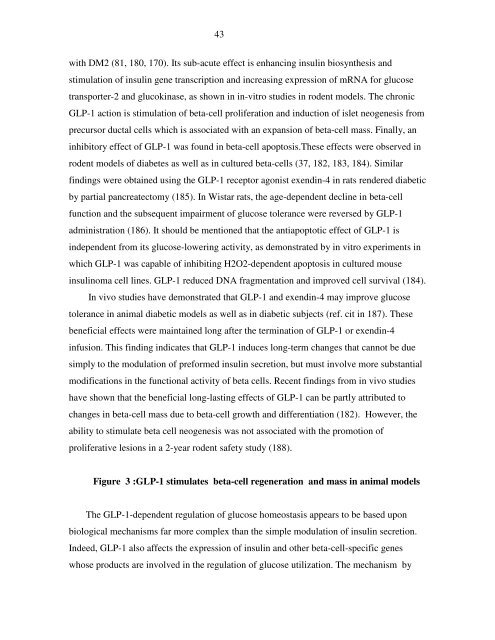1 BETA-CELL FAILURE IN DIABETES AND PRESERVATION BY ...
1 BETA-CELL FAILURE IN DIABETES AND PRESERVATION BY ...
1 BETA-CELL FAILURE IN DIABETES AND PRESERVATION BY ...
Create successful ePaper yourself
Turn your PDF publications into a flip-book with our unique Google optimized e-Paper software.
43<br />
with DM2 (81, 180, 170). Its sub-acute effect is enhancing insulin biosynthesis and<br />
stimulation of insulin gene transcription and increasing expression of mRNA for glucose<br />
transporter-2 and glucokinase, as shown in in-vitro studies in rodent models. The chronic<br />
GLP-1 action is stimulation of beta-cell proliferation and induction of islet neogenesis from<br />
precursor ductal cells which is associated with an expansion of beta-cell mass. Finally, an<br />
inhibitory effect of GLP-1 was found in beta-cell apoptosis.These effects were observed in<br />
rodent models of diabetes as well as in cultured beta-cells (37, 182, 183, 184). Similar<br />
findings were obtained using the GLP-1 receptor agonist exendin-4 in rats rendered diabetic<br />
by partial pancreatectomy (185). In Wistar rats, the age-dependent decline in beta-cell<br />
function and the subsequent impairment of glucose tolerance were reversed by GLP-1<br />
administration (186). It should be mentioned that the antiapoptotic effect of GLP-1 is<br />
independent from its glucose-lowering activity, as demonstrated by in vitro experiments in<br />
which GLP-1 was capable of inhibiting H2O2-dependent apoptosis in cultured mouse<br />
insulinoma cell lines. GLP-1 reduced DNA fragmentation and improved cell survival (184).<br />
In vivo studies have demonstrated that GLP-1 and exendin-4 may improve glucose<br />
tolerance in animal diabetic models as well as in diabetic subjects (ref. cit in 187). These<br />
beneficial effects were maintained long after the termination of GLP-1 or exendin-4<br />
infusion. This finding indicates that GLP-1 induces long-term changes that cannot be due<br />
simply to the modulation of preformed insulin secretion, but must involve more substantial<br />
modifications in the functional activity of beta cells. Recent findings from in vivo studies<br />
have shown that the beneficial long-lasting effects of GLP-1 can be partly attributed to<br />
changes in beta-cell mass due to beta-cell growth and differentiation (182). However, the<br />
ability to stimulate beta cell neogenesis was not associated with the promotion of<br />
proliferative lesions in a 2-year rodent safety study (188).<br />
Figure 3 :GLP-1 stimulates beta-cell regeneration and mass in animal models<br />
The GLP-1-dependent regulation of glucose homeostasis appears to be based upon<br />
biological mechanisms far more complex than the simple modulation of insulin secretion.<br />
Indeed, GLP-1 also affects the expression of insulin and other beta-cell-specific genes<br />
whose products are involved in the regulation of glucose utilization. The mechanism by











